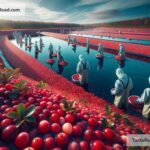Why Cranberries Float in Water: A Simple Explanation
Have you ever seen pictures or videos of vast cranberry bogs, where these little red fruits are floating on the surface of the water? It’s fascinating to watch as farmers use water to harvest cranberries, creating a sea of bright, floating berries. But have you ever wondered why cranberries float in water? Is there something special about them? Let’s dive into the science behind this curious phenomenon, explained in simple terms.
A Berry with a Built-in Life Jacket
The cranberry is a unique fruit, and one of its coolest features is its ability to float. This happens because cranberries have small pockets of air inside them. You can think of these air pockets like tiny balloons that help keep the berries afloat.
Most fruits are denser than water, meaning they don’t have enough air inside to float—they’ll sink instead. But cranberries are different. Their air pockets make them less dense than water, which is why they bob on the surface rather than sink to the bottom. It’s a built-in safety mechanism that helps them stay buoyant, just like life jackets help us stay afloat when swimming.
How Cranberries Grow
To understand why cranberries float, it helps to know how they grow. Cranberries are grown in fields called “bogs,” which are wetlands surrounded by sand and peat (a type of soil). These bogs are low-lying areas that can be flooded with water when needed. Cranberries grow on vines close to the ground and thrive in these acidic, swampy conditions.
During most of the year, cranberry bogs aren’t flooded, so the berries grow on dry land. But when it’s time to harvest the cranberries in the fall, farmers use water as part of the farming process. They flood the bogs, submerging the vines underwater. This is where the magic happens—the cranberries detach from the vines and float to the top.
Why Do Farmers Use Water to Harvest Cranberries?
Cranberries are harvested in two main ways: dry harvesting and wet harvesting. Dry harvesting uses mechanical equipment to pick the berries off the vines, but wet harvesting is the method where cranberries are floated in water.
Wet harvesting takes advantage of the cranberry’s ability to float. Farmers flood the bogs, and then they use machines or tools to agitate the vines, loosening the berries. Since cranberries float, they naturally rise to the surface, creating a beautiful, bright red carpet of floating fruit. From there, farmers use special tools or booms (think of them as floating fences) to gather all the floating cranberries into one area, where they can be scooped up and processed.
This water-based method is efficient and allows farmers to harvest large quantities of cranberries all at once. It also protects the fruit from bruising because the water acts as a cushion, preventing the berries from getting damaged during collection.
The Science Behind Floating
Now let’s take a closer look at the science. Why do cranberries float when other fruits sink? The answer lies in the concept of density.
Density is a measure of how much “stuff” (matter) is packed into a certain amount of space. If something is less dense than water, it will float; if it’s more dense than water, it will sink. Cranberries are less dense than water because they have air pockets inside them. These air pockets make the berries lighter and help them stay on the surface.
In contrast, fruits like apples or grapes don’t have the same amount of air inside, which makes them heavier and more dense than water. That’s why you won’t see apples floating in water during harvest season.
Fun Fact: Cranberries Were Once Called “Bounce Berries”
Another fun fact about cranberries is that they’re sometimes called “bounce berries.” Why? Because of their air pockets, cranberries are not only buoyant but also bouncy! If you drop a cranberry on a hard surface, it can bounce several times. Early farmers even used this bouncing feature to tell if the berries were fresh. Only firm, buoyant cranberries would bounce, while mushy or damaged ones wouldn’t.
The Benefits of Floating Cranberries
The cranberry’s ability to float isn’t just a quirky trait—it actually has practical benefits. Floating makes harvesting easier for farmers, reduces damage to the fruit, and speeds up the process. Plus, it creates those stunning visuals of bright red berries spread across shimmering water that we see in pictures and advertisements.
In nature, floating may also help cranberries spread and grow. Water can carry floating berries to new areas, allowing the seeds inside the fruit to take root and grow into new plants. So, it’s a win-win for both farmers and nature!
Conclusion
Cranberries float in water because they have air pockets inside them that make them less dense than water. This unique feature is why farmers use wet harvesting during cranberry season, flooding the bogs and letting the berries rise to the surface. It’s a clever and efficient way to collect these tart little fruits. So next time you enjoy cranberry sauce with your Thanksgiving dinner or sip cranberry juice, you’ll know the science behind how these berries are harvested—and why they float!


